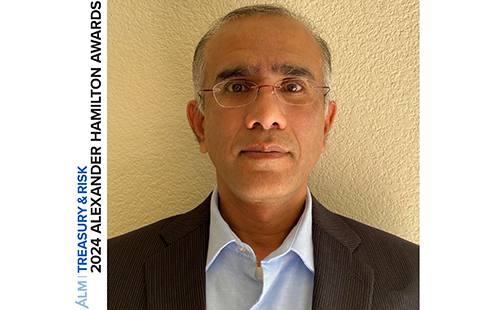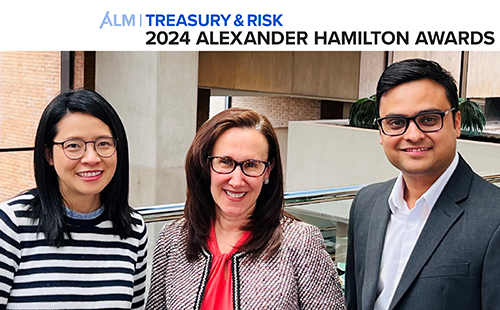
Last year was marked by a variety of shifts in the U.S. business climate in the aftermath of the Covid-19 pandemic. Interest rates rose precipitously, while inflation continued to moderate. Early in the year, several bank failures led to concerns about financial institutions' stability. And technology continued to drive "digital transformation" in businesses of all sizes, across industries.
As we embarked on 2024, Treasury & Risk checked in with Erik Smolders, a managing director in the Global Treasury Advisory Services group at Deloitte and the former treasurer of Ingram Micro, to see what he thinks treasurers should doing to prepare for the year ahead.
Recommended For You
Treasury & Risk: What should treasurers be thinking about as 2024 gets under way?
Erik Smolders: One big topic that should be on the radar for treasury teams is Pillar Two. It is essentially a new iteration of BEPS [Base Erosion and Profit Shifting], a global tax initiative designed to improve the alignment of economic activities, risks, and capital with the taxable profits they generate. Pillar Two will be even more global than BEPS—I think every country has endorsed the concept—further advancing the idea of a worldwide minimum tax.
Now, treasury is not the primary function within an organization that will be dealing with Pillar Two, unless the treasurer also has responsibility for tax. But treasurers need to be aware of how Pillar Two's changes in tax rules are going to affect their organization.
T&R: What changes does Pillar Two entail?
ES: When I talk to our tax team, they tell me there is nothing treasurers should do related to Pillar Two because the setup of their in-house banking and treasury structures should not be primarily tax-driven. They should be set up to create operational efficiencies, reduce excess cash, reduce banking relationships, improve hedging—those sorts of things.
While I understand that reply, Pillar Two is going to impact how corporate cash flows work, maybe how upstream dividends flow, and how intercompany transactions should happen from a transfer-pricing point of view. Treasurers will have to deal with those impacts.
I don't anticipate that companies will be making major changes as a result of Pillar Two, like deciding to move their treasury center from one country to another. If a company has designed its treasury structure to be located somewhere that it doesn't have to pay taxes at all, then Pillar Two might lead to big changes because the tax advantages the business was counting on will no longer exist. But, like I said, we do not recommend building treasury structures from a purely tax-savings point of view.
 For most treasury teams, Pillar Two should lead to close collaboration with the tax group to make sure that the company is addressing the rules changes and that treasury structures are flexible enough to accommodate the changes in cash flows that will happen. In-house banking, intercompany funding, and cash pooling will all need to be consistent with the new rules around Pillar Two. The new rules might also impact cash forecasting if payment patterns are impacted. And there is a chance loans will need to be rewritten because the parties to the loan will now be equity-funded rather than debt-funded.
For most treasury teams, Pillar Two should lead to close collaboration with the tax group to make sure that the company is addressing the rules changes and that treasury structures are flexible enough to accommodate the changes in cash flows that will happen. In-house banking, intercompany funding, and cash pooling will all need to be consistent with the new rules around Pillar Two. The new rules might also impact cash forecasting if payment patterns are impacted. And there is a chance loans will need to be rewritten because the parties to the loan will now be equity-funded rather than debt-funded.
Now is the time for treasury to be thinking through all the impacts Pillar Two may have on cash flows moving from one legal entity to another, and making sure everything that needs to happen can happen.
T&R: What other trends should treasurers be looking at in 2024?
ES: Changes in interest rates will continue to be top-of-mind. We seem to be at the end of the Fed's rate-raising cycle. Treasury needs to be looking at how that is going to impact the company's interest rate position.
Obviously, external debt is a key concern. Treasury might need to rethink the company's funding structure and whether it uses fixed- vs. floating-rate debt. Interest rates will also impact intercompany funding in 2024. Treasury needs to look at how intercompany loans should evolve in the current rate environment.
My team is also getting a lot of requests to look at in-house banking and cash pooling, and I expect that to continue. Now that rates are higher, treasury groups need to make sure the company's cash is moving up the organization so that it's available to either invest or pay down debt.
It's important to keep in mind that even though rates might come down a little bit later this year, they are not going to return to zero anytime soon; rates will stay more elevated than they've been over the past 10 years. So the drive to reduce idle cash and make sure money is sitting in interest-bearing accounts is going to continue.
T&R: Are there any ways in which the rising-rate environment seems to have taken treasury groups by surprise?
ES: Yes. One interesting impact of interest rate volatility is the substantial increase in the cost of FX [foreign exchange] hedging. If you buy a forward, the difference between the spot rate and the forward rate is driven by the difference in interest rates between the two currencies. So if you're buying euros and selling dollars forward, the spread between the euro interest rate and the dollar interest rate is going to impact your cost of hedging. That's something some organizations hadn't really thought about until rates started rising and they felt the impact.
Every country is not in the same place, at the same time, on the cycle of rising and falling interest rates, which means the cost of hedging has swung pretty wildly over the past few years. When dollar interest rates went up faster than euro interest rates, hedging the euro-dollar pair became a lot more expensive for U.S. businesses importing products from Europe. And I don't think anyone saw that coming. The cost of hedging is usually pretty stable, but it hasn't been over the past year.
Now that we're heading for a cycle where the U.S. might cut interest rates faster than Europe, the same thing might happen again. So treasurers should pay close attention to the cost of hedging in 2024. It's not something that companies should just take on the chin—and into their margins—because they didn't fully understand it until it was too late. The cost of hedging is a cost of doing business that needs to be pushed through to the commercial side.
Treasury teams need to work with procurement and sales to make sure the company is optimizing decisions around which currency it uses for each transaction. If you're an importer, do you really need to import in the currency of the seller, or can you tell the seller you want to import in your own currency? And if you're an exporter, do you really need to export in the currency of your buyer, or can you export in your home currency? Treasurers are not always driving these decisions on either the procurement or sales side. But hedges come at a cost, and that cost is something treasury needs to be looking at in conjunction with the teams making decisions about transactions' currency.
T&R: So you're encouraging treasurers to make sure—as interest rate differentials start to change again as countries lower rates—that they have a seat at the table in discussing which currencies sales and materials are priced in?
ES: Yes. And not just right now: That is how companies should always operate. But it's worth noting that some treasurers sit in their ivory towers, doing cash management and hedging and other core treasury activities while isolated from the rest of the business. Other treasurers are actively involved in, and part of the fabric of, the business. Falling in that latter category is important in a range of areas, one of which is decision-making around transactions' currency.
In the coming year, volatility in the cost of currency hedging is going to increase. Treasury needs to make sure, at the very least, that someone in the organization is having discussions with suppliers and customers around who takes the risk in the transaction anytime FX is involved.
T&R: What about counterparty risk management in banking relationships?
ES: That's a continuing story, but something treasurers should not forget in 2024. Back in 2008, treasurers began actively managing their organization's bank risk. Over the years, that became less top-of-mind for many treasury teams. But then, as some smaller banks got into trouble last year, counterparty risk management in banking relationships became a hot topic again.
As treasurers consider the risk their banking partners pose, they need to look more broadly than just 'We have some money invested with Bank A, and we have to be careful to keep that money safe.' They need to think about their banks as key components of their supply chain. A company needs to be able to pay its suppliers. It needs to be able to collect from customers. It needs to be able to meet payroll obligations and pay other expenses. Without the bank, these things are not possible.
So treasurers should think about banks like they view other suppliers, asking: What is the risk if this supply-chain partner fails? And how do I cover or mitigate that risk? Some treasury teams had forgotten that approach after 2008, and it came back into the spotlight last year.
T&R: So, you think Pillar Two, interest rate impacts, and bank counterparty risk management should be the key issues on treasurers' radars as we move into 2024?
ES: One other topic that treasurers will need to wrestle with in 2024 is generative AI [artificial intelligence]. Activities like cash forecasting and determining currency exposures are going to undergo big evolutions as generative AI becomes more widespread. Detecting patterns is one of the things that AI is best at, and when you think about cash flows and seasonality, that's all about recognizing patterns. I think we're going to see an evolution in technology that leads to better forecasting capabilities with AI. Technology vendors are developing those capabilities as we speak.
T&R: Do you have concerns about the accuracy of the data produced by generative AI systems? We published an article last year that included a pretty stern warning not to put too much faith in these systems, at least right now. The basic message was that the quality of what comes out is only as good as the quality of what goes in, and treasurers need to take precautions to make sure they have confidence in the numbers coming out of any system based on generative AI.
ES: I fully agree. I wouldn't rely 100 percent on a tool like that without some good sanity checks. The cash forecast is looking at trends, and there are always going to be unforeseen events that affect those trends. For example, the launch of a new product or a big external event cannot be predicted by looking at historical cash flows. Forecasting decisions require a combination of human intelligence and artificial intelligence. But hopefully AI will make forecasting more efficient and help treasury teams produce a more accurate forecast overall.
One thing we see in all our Deloitte treasury surveys: Nearly every treasury—somewhere around 90 percent of respondents—complains about the accuracy of the cash forecast. There's always room for improvement, and I think generative AI can take treasury teams in that direction.
© Touchpoint Markets, All Rights Reserved. Request academic re-use from www.copyright.com. All other uses, submit a request to [email protected]. For more inforrmation visit Asset & Logo Licensing.



